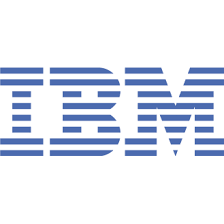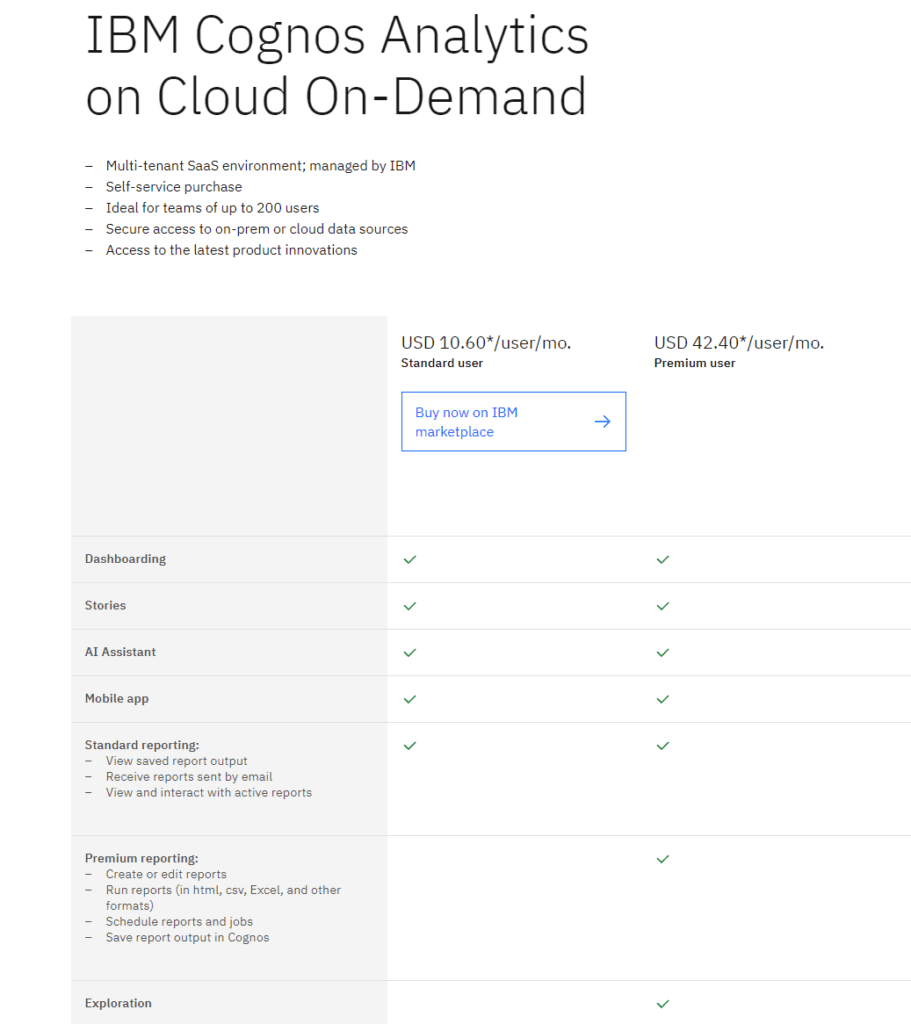Choosing the right analytics tool for your business is like picking the perfect pair of shoes. It’s not just about what looks good but what fits your needs, helps you move forward faster, and is comfortable for the long haul. Today, we’re diving into a head-to-head comparison between two giants in the analytics world: Domo and IBM Cognos Analytics. Whether you’re a data analyst, a business owner, or just someone intrigued by the power of data, this guide is tailored to help you make an informed decision. So, let’s lace up and dive in.
| Domo | IBM Cognos Analytics |
|---|---|
 |  |
| G2 Score – 4.4 out of 5 stars | G2 Score – 4.0 out of 5 stars |
| TrustRadius Score – 8.5/10 | TrustRadius Score – 8.1/10 |
Ease of Use
User Interface and Experience
One of the most critical factors when choosing an analytics tool is its ease of use. After all, what good is a powerful tool if it’s too complex to navigate? Let’s compare Domo and IBM Cognos Analytics from the lens of their user interface and experience.
Domo: The Modern Navigator
Starting with Domo, it’s like walking into a friendly, inviting cafe where everything is designed to make your stay enjoyable and productive. The platform prides itself on its modern, intuitive interface that greets users of all technical backgrounds with open arms. This welcoming nature extends to its dashboard functionality, where users can effortlessly drag and drop different elements to create custom views of their data. It’s akin to crafting your perfect cup of coffee, where everything from the roast to the milk is tailored to your taste. The beauty of Domo lies in its ability to make complex data analysis feel approachable, turning the daunting task of data crunching into an enjoyable process.
Moreover, Domo’s mobile responsiveness ensures that this ease of use isn’t confined to the desktop. It understands that we live in a mobile-first world, where decisions need to be made on the move, and insights should be at our fingertips – literally. This approach empowers users to stay connected with their data, anytime and anywhere, making it a powerful ally in the quest for data-driven decision-making.
IBM Cognos Analytics: The Experienced Guide
Shifting focus to IBM Cognos Analytics, we enter a more traditional, albeit no less powerful, environment. Here, the emphasis is on depth and precision, catering to users who have a specific journey in mind – from raw data to detailed reports. Cognos might initially present itself as a tool with a steeper learning curve, reminiscent of mastering a complex piece of classical music. However, this complexity is by design, aimed at providing a rich, detailed canvas upon which users can paint their data stories.
Cognos has been evolving, striving to bridge the gap between powerful functionality and user-friendly design. Recent updates have seen improvements in navigation and visualization, making it easier for new users to get acquainted with the tool. Yet, the essence of Cognos remains its comprehensive suite of features that cater to the needs of data professionals looking for granular control over their analysis and reporting processes.
Data Integration and Management
Handling Data from Multiple Sources
In today’s world, data comes at us like a torrential downpour from multiple sources. Managing this data efficiently is crucial for any analytics tool. Let’s see how Domo and IBM Cognos Analytics fare in the realm of data integration and management.
Domo: The Conductor of the Data Symphony
Imagine you’re conducting an orchestra. Each musician (data source) has a unique sound, but when combined correctly, they create beautiful music. Domo excels in this area, acting as the maestro of data integration. It boasts over 1,000 connectors, allowing it to seamlessly integrate with a myriad of data sources, including cloud services, databases, and social media platforms. This extensive connectivity means you can bring together data from different departments or systems into a unified view without missing a beat.
Furthermore, Domo’s real-time data processing capabilities ensure that your data is always up-to-date, like a live performance. This is particularly beneficial for businesses that rely on timely data to make quick decisions. Domo’s approach to data management is like having a smart assistant who not only gathers all your mail but also sorts and prioritizes it for you.
IBM Cognos Analytics: The Seasoned Archivist
IBM Cognos Analytics approaches data integration with the precision of a seasoned archivist. It offers robust capabilities for connecting to and importing data from various sources, including relational databases, flat files, and cloud repositories. Cognos provides powerful ETL (Extract, Transform, Load) tools, which allow users to cleanse, enrich, and transform data before it’s analyzed. This meticulous preparation process ensures that the data is in the best possible shape for analysis, like restoring and organizing ancient manuscripts for study.
Cognos also offers strong governance and data management policies, making it an excellent choice for organizations with stringent data security and compliance requirements. Its approach is more like a library where every book (data source) is carefully cataloged and preserved for future generations. This level of detail and control is perfect for businesses that need to manage large volumes of complex data across different regulatory environments.
Visualization and Reporting
Bringing Data to Life
Data visualization and reporting are where numbers and insights take visual form, making complex information accessible and actionable. Let’s explore how Domo and IBM Cognos Analytics turn data into compelling narratives.
Domo: The Visual Storyteller
Domo is like a gifted storyteller who can captivate any audience. Its visualization capabilities are designed to make data not only informative but also engaging. With a wide array of charts, graphs, and custom visualization options, Domo allows users to present their data in the most effective way possible. Think of it as having an art studio where you can paint your data stories on a blank canvas, using colors and shapes that resonate with your audience.
One of Domo’s standout features is its Card and Page design. Cards are individual visualizations or reports that can be combined on Pages to create a comprehensive dashboard. This modular approach makes it easy to customize dashboards for different users or departments, ensuring that everyone has access to the insights they need. Whether you’re creating a simple bar chart or a complex interactive dashboard, Domo provides the tools to bring your data to life vividly and dynamically.
Moreover, Domo’s emphasis on social sharing and collaboration means your data stories can be easily shared and discussed within your team or organization. It’s like publishing your book and having readers around the world interact with your stories in real time.
IBM Cognos Analytics: The Data Detective
IBM Cognos Analytics, on the other hand, approaches data visualization with the meticulousness of a detective piecing together clues. Its reporting and visualization capabilities are powerful and sophisticated, designed to handle complex data scenarios. Cognos allows users to create highly customizable reports and dashboards that can accommodate the specific requirements of any business. With advanced analytics features, including predictive analytics and automated pattern detection, Cognos helps uncover hidden insights within your data.
Cognos’ reporting tool is like having a magnifying glass that can zoom in on the most minute details or zoom out for a broader perspective. It supports a wide range of report formats, from simple lists and crosstabs to intricate interactive dashboards. This flexibility makes it an excellent choice for organizations that need to produce detailed, formal reports regularly.
Additionally, Cognos’ enterprise-grade features ensure that these insights can be distributed securely across an organization. This is akin to a detective sharing their findings in a way that’s both comprehensive and confidential, ensuring that the right people have access to the right information at the right time.

Related: Check out our free SEO suite

Scalability and Performance
Growing with Your Data
As businesses evolve, so do their data analytics needs. Scalability and performance are critical factors that determine whether an analytics tool can grow with your business or if it will become a bottleneck. Let’s delve into how Domo and IBM Cognos Analytics stack up in these aspects.
Domo: Scaling with Flexibility
Think of Domo as a high-speed train that’s built to adjust its speed and capacity based on the number of passengers. It’s designed with scalability in mind, allowing businesses to start small and expand their data analytics capabilities as they grow. Thanks to its cloud-native architecture, Domo can handle increases in data volume and user load without skipping a beat. This means that whether your business is just starting to gather steam or is already running at full speed, Domo can keep pace.
The platform’s performance remains consistent even as demands grow, thanks to its distributed cloud infrastructure and efficient data processing engine. This ensures that your dashboards and reports are always up-to-date and accessible, regardless of how much data you’re working with. For businesses that anticipate growth or experience seasonal fluctuations, Domo’s flexibility and scalability are like having a vehicle that automatically adapts to the road conditions and traffic, ensuring a smooth ride throughout.
IBM Cognos Analytics: Enterprise-Level Power
IBM Cognos Analytics is like a fortified castle designed to withstand sieges. It’s built for enterprise-level performance and scalability, making it a solid choice for large organizations with complex data environments. Cognos’ scalability is supported by a robust infrastructure that can handle large volumes of data and complex, computationally intensive analytics without breaking a sweat.
The platform is designed to scale horizontally, allowing additional resources to be added as needed. This means that as your business grows and your data analysis requirements become more complex, Cognos can grow with you, ensuring that performance is not compromised. It’s particularly well-suited for organizations that need to maintain high performance across a large number of users, extensive datasets, and complex reporting requirements.
Moreover, IBM’s focus on reliability and performance optimization ensures that Cognos Analytics remains efficient and responsive, even under heavy loads. For businesses that depend on large-scale data analysis and need a tool that can grow with them while maintaining high levels of performance and security, Cognos offers a sturdy foundation.
Customization and Flexibility
In the world of analytics, one size rarely fits all. The ability to customize and adapt the tool to fit the unique needs of your organization can be the difference between a good analytics platform and a great one. Let’s explore how Domo and IBM Cognos Analytics stack up in terms of customization and flexibility.
Domo
Domo prides itself on its adaptability, catering to businesses looking for a tool that can mold to their specific requirements. Its platform is like a chameleon, blending into your organization’s landscape by allowing extensive customization options. From dashboards and reports to data connections, Domo provides a toolkit that encourages users to tailor the system to their needs. This customization extends to the aesthetic elements, allowing companies to brand their dashboards and reports, making Domo feel like an integrated part of their business.
Moreover, Domo’s flexibility isn’t just skin deep. The platform supports a broad range of data connectors and offers robust APIs for integrating with external systems. This open-ended approach ensures that Domo can fit into any data ecosystem, regardless of the existing technology stack. It’s like having a universal adapter when traveling to different countries; whatever the plug shape, Domo can connect.
IBM Cognos Analytics
On the flip side, IBM Cognos Analytics offers a different kind of customization and flexibility, one rooted in its storied history in the business intelligence world. IBM Cognos is built to accommodate complex, multifaceted organizations with diverse reporting and analysis needs. It offers a deep level of customization that allows businesses to fine-tune every aspect of their analytics, from the data model to the final output.
Cognos’ approach to flexibility is more structured than Domo’s, providing a comprehensive set of tools that cater to professional data analysts and IT departments. This structure ensures that, even though customization options are abundant, they are implemented in a controlled and scalable manner. It’s akin to building a custom home with a seasoned architect; you have the freedom to design your dream house, but within the bounds of architectural best practices.
Pricing
Domo

IBM Cognos Analytics

Conclusion
Domo emerges as a highly user-friendly, agile, and adaptable platform, ideal for businesses seeking a modern, intuitive analytics tool that can grow with them. Its strength lies in its ability to make data accessible and actionable for users of all skill levels, ensuring that insights are not just generated but also engaged with and acted upon. Domo’s appeal is in its simplicity, flexibility, and the democratization of data across the organization, making it a strong candidate for companies prioritizing speed to insight and user engagement.
IBM Cognos Analytics, on the other hand, stands as a testament to depth, control, and enterprise-grade robustness. It caters to organizations with complex data environments who require detailed, customizable reporting and analytics capabilities. Cognos offers a level of precision and governance that is hard to match, making it suitable for large enterprises or those in heavily regulated industries. Its structured approach to analytics ensures that even the most intricate data can be harnessed, analyzed, and turned into actionable insights.
Read Next:
- Productivity Strategies and Tactics (According to 60+ Experts): Become An Efficiency Monster!
- 19+ Top Customer Relationship Management (CRM) Software: What’s Best?
- 25 Ways to Get More Views and Engagement on Your Instagram Reels (Fast!)
- 7 Key Ways How Law Firms are Marketing Themselves: Disclosed!
- 31+ Top Social Media Management tools Compared! (2023)





















